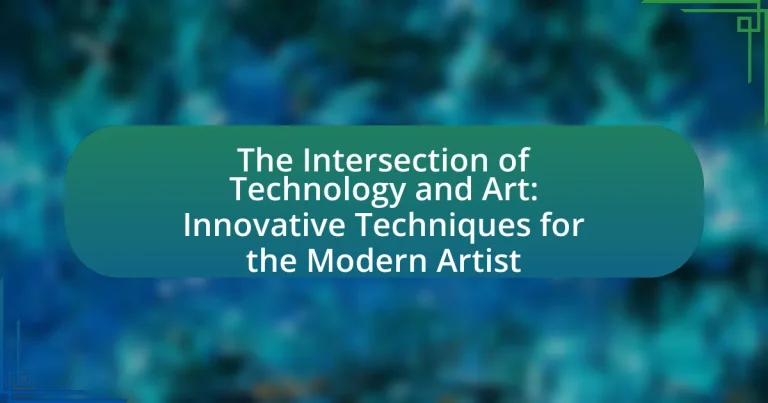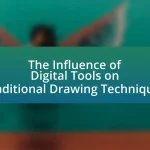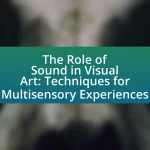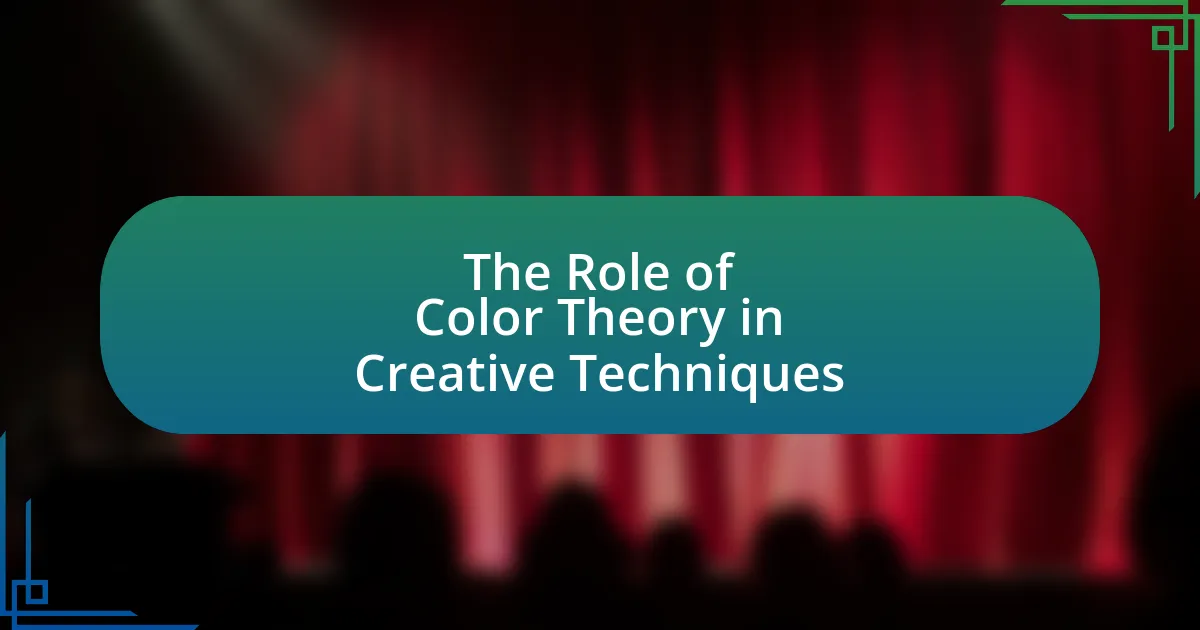The article explores the intersection of technology and art, highlighting how digital tools and innovative techniques are reshaping artistic practices. It examines the influence of technology on the evolution of art, historical milestones that mark this convergence, and contemporary artists’ use of digital mediums. Key topics include the significance of technology in expanding creative possibilities, the emergence of innovative techniques such as augmented reality and artificial intelligence, and the challenges artists face in adopting new technologies. Additionally, the article discusses resources and communities available for artists interested in integrating technology into their work.

What is the Intersection of Technology and Art?
The intersection of technology and art refers to the integration of digital tools and innovative techniques into artistic practices, enabling new forms of expression and creativity. This convergence has led to the emergence of digital art, interactive installations, and augmented reality experiences, which expand the boundaries of traditional art forms. For instance, the use of software like Adobe Creative Suite allows artists to manipulate images and create complex designs that were previously unattainable. Additionally, technologies such as 3D printing and virtual reality provide artists with novel mediums to explore and engage audiences in immersive ways. This relationship not only enhances artistic capabilities but also transforms how art is experienced and consumed in contemporary society.
How has technology influenced the evolution of art?
Technology has significantly influenced the evolution of art by introducing new mediums and techniques that expand creative possibilities. For instance, the advent of digital tools such as graphic design software and 3D modeling programs has allowed artists to create works that were previously unimaginable, enabling intricate designs and virtual installations. Additionally, the rise of the internet has transformed how art is shared and consumed, with platforms like social media facilitating global exposure and collaboration among artists. Historical examples include the use of photography in the 19th century, which challenged traditional painting methods, and the emergence of digital art in the late 20th century, which has led to new genres like digital painting and generative art. These technological advancements have not only redefined artistic practices but also broadened the audience’s engagement with art.
What historical milestones mark the convergence of technology and art?
The historical milestones that mark the convergence of technology and art include the invention of the printing press in the 15th century, which revolutionized the distribution of art and literature, and the advent of photography in the 19th century, which transformed visual representation. The introduction of digital technology in the late 20th century, particularly with the development of computer graphics and software like Adobe Photoshop, further blurred the lines between traditional art forms and technology. Additionally, the rise of the internet in the 1990s enabled artists to share their work globally and collaborate in new ways, exemplified by platforms like DeviantArt. These milestones demonstrate how technological advancements have continually influenced artistic expression and accessibility.
How do contemporary artists utilize technology in their work?
Contemporary artists utilize technology in their work by integrating digital tools, software, and innovative mediums to enhance creativity and expand artistic expression. For instance, artists employ digital painting software like Adobe Photoshop and Procreate to create intricate artworks that blend traditional techniques with digital capabilities. Additionally, many contemporary artists use 3D printing technology to produce sculptures and installations that would be difficult or impossible to create by hand. The use of augmented reality (AR) and virtual reality (VR) allows artists to create immersive experiences, engaging audiences in new ways. According to a report by the National Endowment for the Arts, 60% of artists in the U.S. incorporate technology into their creative processes, demonstrating the significant impact of technological advancements on contemporary art practices.
Why is the intersection of technology and art significant today?
The intersection of technology and art is significant today because it fosters innovation and expands creative possibilities for artists. This convergence allows for the creation of new mediums, such as digital art and interactive installations, which engage audiences in unprecedented ways. For instance, the use of virtual reality in art exhibitions has transformed how viewers experience and interact with artworks, making art more accessible and immersive. Additionally, technology enables artists to reach global audiences through online platforms, enhancing visibility and collaboration. According to a report by the National Endowment for the Arts, digital art forms have seen a substantial increase in popularity, reflecting a shift in how art is produced and consumed in the contemporary landscape.
What cultural shifts have prompted this intersection?
The cultural shifts that have prompted the intersection of technology and art include the rise of digital media, the democratization of artistic tools, and the increasing value placed on interdisciplinary collaboration. The proliferation of the internet and digital platforms has enabled artists to reach wider audiences and experiment with new forms of expression, such as digital painting, virtual reality, and interactive installations. Additionally, advancements in technology have made sophisticated tools accessible to a broader range of creators, allowing for innovative techniques that blend traditional art forms with modern technology. This shift is evidenced by the growing number of exhibitions showcasing digital art and the integration of technology in art education, reflecting a cultural embrace of new mediums and collaborative practices.
How does this intersection reflect societal changes?
The intersection of technology and art reflects societal changes by demonstrating how digital tools and platforms have transformed creative expression and accessibility. This shift allows artists to reach wider audiences through social media and online galleries, breaking geographical barriers and democratizing art. For instance, the rise of digital art forms, such as NFTs, illustrates a significant change in how art is valued and traded, aligning with contemporary economic trends and consumer behavior. Additionally, technology facilitates collaboration across diverse disciplines, fostering innovation and inclusivity in artistic practices, which mirrors broader societal movements towards diversity and representation in the arts.

What Innovative Techniques are Emerging for Modern Artists?
Innovative techniques emerging for modern artists include augmented reality (AR), virtual reality (VR), and artificial intelligence (AI) integration in art creation. These technologies enable artists to create immersive experiences and interactive installations that engage audiences in novel ways. For instance, AR allows artists to overlay digital elements onto physical spaces, enhancing traditional artworks with dynamic content. VR provides a fully immersive environment where viewers can experience art from new perspectives. AI tools, such as generative algorithms, assist artists in producing unique pieces by analyzing vast datasets and generating original designs. These techniques reflect the growing synergy between technology and artistic expression, as evidenced by exhibitions like the “AI: More than Human” at the Barbican Centre, which showcased the impact of AI on contemporary art.
How are digital tools transforming artistic practices?
Digital tools are transforming artistic practices by enabling artists to create, collaborate, and distribute their work in innovative ways. These tools, such as graphic design software, digital painting applications, and 3D modeling programs, allow for greater experimentation and flexibility in the creative process. For instance, artists can manipulate images with precision, explore virtual reality environments, and utilize algorithms to generate unique artworks. The rise of platforms like Instagram and digital galleries has also changed how art is shared and consumed, allowing artists to reach global audiences instantly. According to a report by the National Endowment for the Arts, 53% of artists now use digital tools in their practice, highlighting the significant impact of technology on contemporary art.
What software and applications are essential for modern artists?
Essential software and applications for modern artists include Adobe Creative Cloud, Procreate, Corel Painter, and Blender. Adobe Creative Cloud offers a suite of tools like Photoshop and Illustrator, which are industry standards for digital art and graphic design. Procreate is favored for its intuitive interface and powerful features tailored for digital painting on iPads. Corel Painter is known for its realistic brush simulation, making it ideal for traditional art styles in a digital format. Blender is a comprehensive 3D modeling and animation software that allows artists to create intricate 3D art and animations. These applications are widely used in the art community, demonstrating their importance in contemporary artistic practices.
How do digital mediums compare to traditional art forms?
Digital mediums offer distinct advantages over traditional art forms, primarily in terms of accessibility, versatility, and ease of modification. Digital art can be created and shared globally with minimal cost, allowing artists to reach wider audiences compared to traditional methods that often require physical materials and gallery space. Additionally, digital tools enable artists to experiment with various styles and techniques without the constraints of physical media, as seen in software like Adobe Photoshop and Procreate, which provide endless possibilities for manipulation and layering. Furthermore, digital artworks can be easily edited or revised, a feature not available in traditional art forms, which often require significant effort to alter. This flexibility and accessibility have led to a significant increase in the popularity of digital art, evidenced by the rise of online platforms for showcasing and selling digital works.
What role does artificial intelligence play in art creation?
Artificial intelligence plays a significant role in art creation by enabling artists to generate new forms of artwork through algorithms and machine learning techniques. AI tools, such as generative adversarial networks (GANs), allow for the creation of unique images, music, and even literature by analyzing existing works and producing novel outputs based on learned patterns. For instance, the AI program DeepArt uses neural networks to transform photographs into artworks in the style of famous painters, demonstrating how AI can mimic artistic styles and techniques. Additionally, AI can assist artists in the creative process by providing inspiration, automating repetitive tasks, and enhancing collaboration, thus expanding the possibilities of artistic expression.
How can AI enhance the creative process for artists?
AI can enhance the creative process for artists by providing tools that facilitate idea generation, streamline workflows, and offer new forms of expression. For instance, AI algorithms can analyze vast datasets of existing artworks to inspire artists with unique styles or concepts, enabling them to explore creative avenues they may not have considered. Additionally, AI-driven software can automate repetitive tasks, such as color correction or image resizing, allowing artists to focus more on the creative aspects of their work. Research from the University of California, Berkeley, highlights that artists using AI tools reported a 30% increase in productivity and a broader exploration of artistic styles, demonstrating the tangible benefits of integrating AI into the creative process.
What ethical considerations arise from AI-generated art?
AI-generated art raises several ethical considerations, primarily concerning authorship, copyright, and the potential for bias. Authorship issues arise because it can be unclear who owns the rights to art created by algorithms, especially when the AI is trained on existing works. Copyright concerns stem from the possibility that AI may replicate styles or elements from copyrighted material without proper attribution, leading to legal disputes. Additionally, bias in AI training data can result in artworks that reflect societal prejudices, raising questions about representation and inclusivity in the art world. These considerations highlight the need for clear guidelines and ethical frameworks to navigate the complexities of AI in artistic creation.
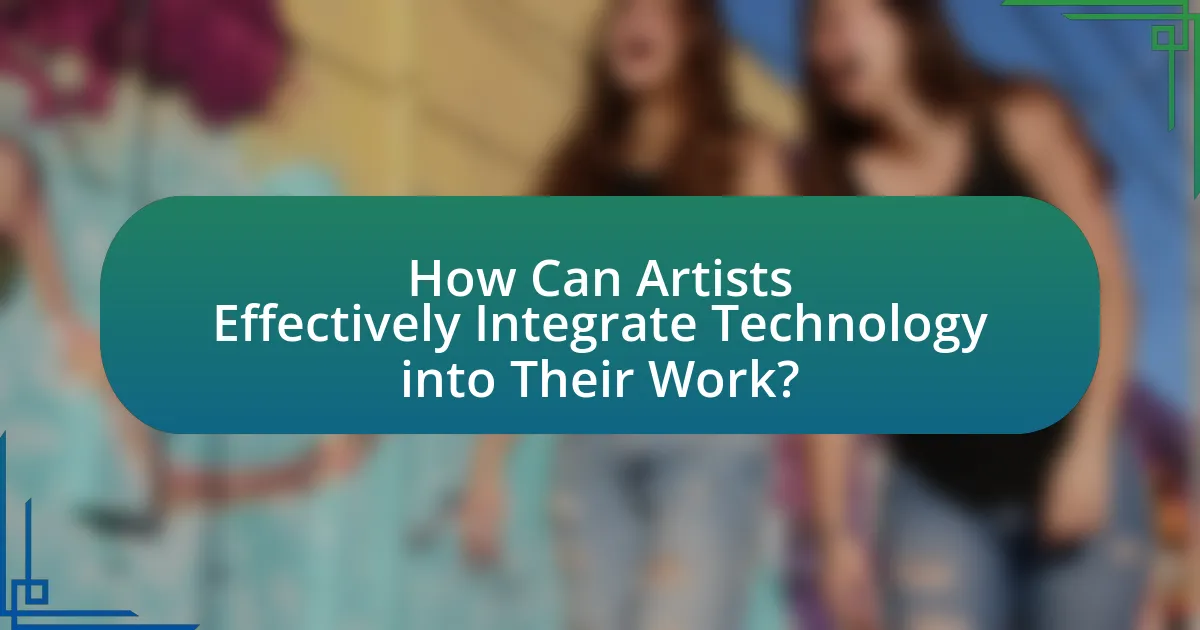
How Can Artists Effectively Integrate Technology into Their Work?
Artists can effectively integrate technology into their work by utilizing digital tools and platforms to enhance creativity and reach wider audiences. For instance, software like Adobe Creative Suite allows artists to create and manipulate images, while 3D modeling tools enable the design of intricate sculptures. Additionally, social media platforms provide artists with a means to showcase their work globally, facilitating direct engagement with audiences. According to a 2021 survey by the National Endowment for the Arts, 53% of artists reported using digital technology to create or distribute their work, highlighting the growing importance of technology in the art world.
What are the best practices for using technology in art?
The best practices for using technology in art include integrating digital tools for creation, utilizing online platforms for collaboration, and employing data analytics for audience engagement. Artists should leverage software like Adobe Creative Suite for design and animation, which enhances creativity and efficiency. Collaboration tools such as Google Drive and Slack facilitate communication and project management among artists, enabling diverse input and innovation. Additionally, using analytics tools like Google Analytics helps artists understand audience preferences and tailor their work accordingly, leading to increased visibility and impact. These practices are supported by the growing trend of digital art sales, which reached $2.6 billion in 2021, indicating a robust market for technology-driven art.
How can artists choose the right tools for their projects?
Artists can choose the right tools for their projects by assessing their specific artistic goals, the medium they intend to use, and the technical requirements of their work. For instance, an artist focusing on digital art may prioritize software like Adobe Photoshop or Procreate, while a painter might select high-quality brushes and paints suited to their style. Additionally, artists should consider the ergonomics and usability of tools, as well as their budget constraints. Research indicates that the right tools can significantly enhance creativity and efficiency, as seen in a study by the National Endowment for the Arts, which found that artists who utilize appropriate tools report higher satisfaction and productivity in their work.
What common challenges do artists face when adopting new technologies?
Artists commonly face challenges such as a lack of technical skills, resistance to change, and financial constraints when adopting new technologies. The rapid pace of technological advancement often leaves artists struggling to keep up, as many may not have the necessary training or experience to effectively utilize new tools. Additionally, some artists may be hesitant to alter their traditional practices, fearing that new technologies could compromise their artistic integrity. Financial limitations also pose a significant barrier, as the cost of new equipment and software can be prohibitive, particularly for emerging artists. These challenges are well-documented in studies highlighting the difficulties artists encounter in integrating technology into their creative processes.
What resources are available for artists exploring technology?
Artists exploring technology have access to various resources, including online platforms, workshops, and funding opportunities. Online platforms such as Adobe Creative Cloud and Blender provide tools for digital art creation and 3D modeling. Workshops offered by institutions like the School of Visual Arts and local art centers teach skills in digital media and interactive installations. Additionally, funding opportunities from organizations like the National Endowment for the Arts support projects that integrate technology and art, enabling artists to experiment and innovate. These resources collectively enhance artists’ capabilities in merging artistic expression with technological advancements.
Where can artists find tutorials and workshops on tech integration?
Artists can find tutorials and workshops on tech integration through various online platforms and educational institutions. Websites like Skillshare, Udemy, and Coursera offer a range of courses specifically focused on integrating technology into artistic practices. Additionally, organizations such as the New Media Arts and the Creative Coding Club provide workshops that emphasize the fusion of art and technology. These platforms and organizations are recognized for their comprehensive resources and expert-led sessions, making them reliable sources for artists seeking to enhance their skills in tech integration.
What communities exist for artists interested in technology?
Communities for artists interested in technology include platforms like Creative Coding, which focuses on the intersection of art and programming, and the Digital Art Community on social media, where artists share their tech-based artworks. Additionally, organizations such as the New Media Art and Technology (NMAT) group provide resources and networking opportunities for artists exploring digital mediums. These communities foster collaboration and innovation, evidenced by events like the SIGGRAPH conference, which showcases advancements in computer graphics and interactive techniques, attracting artists and technologists alike.
What tips can help artists navigate the intersection of technology and art?
Artists can navigate the intersection of technology and art by embracing digital tools, experimenting with new mediums, and engaging with online communities. Utilizing software like Adobe Creative Suite or Procreate allows artists to create and manipulate their work in innovative ways, enhancing their creative process. Experimenting with mediums such as virtual reality or augmented reality can lead to unique artistic expressions that resonate with contemporary audiences. Engaging with online communities, such as social media platforms or art forums, provides artists with valuable feedback, collaboration opportunities, and exposure to diverse perspectives, which can enrich their artistic practice. These strategies are supported by the increasing integration of technology in art, as seen in exhibitions that showcase digital art and interactive installations, highlighting the relevance of technology in modern artistic expression.
